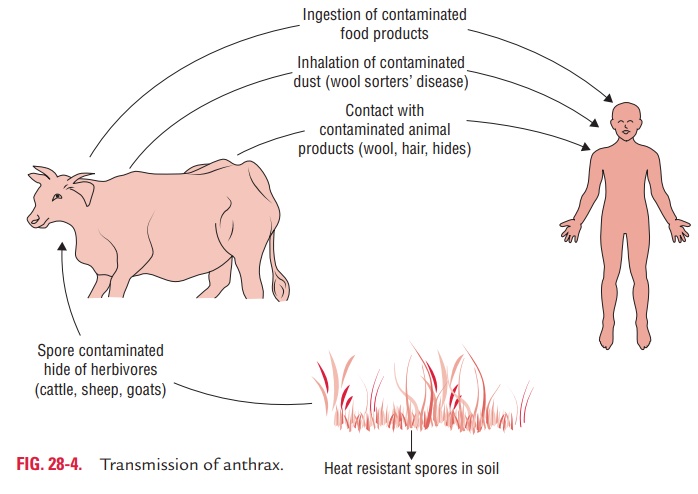Chapter: Microbiology and Immunology: Bacteriology: Bacillus
Epidemiology - Bacillus anthracis
Epidemiology
◗ Geographical distribution
Anthrax is nearly worldwide in distribution, occurring in the soil in the form of extremely resistant spores. These spores cause infection in humans and in farm and wild animals that have grazed on contaminated land or ingested contaminated food. The extent of disease is approximately 20,000–100,000 cases annually, throughout the world.
· The condition is frequently documented in the Middle East, in Africa, Asia, Latin America, and in the Indian subconti-nent despite vaccination programs.
· Epidemics of human anthrax have been reported from Russia and Zimbabwe.
· Sporadic outbreaks have occurred as a result of both agri-cultural and military disruptions. Failure of vaccination programs in livestocks led to a human epidemic, causing 6500 anthrax cases and 100 fatalities during the 1978 Rhodesian civil war. In the former Soviet Union, a mishap at a military microbiology facility resulted in at least 66 deaths in 1979.
· Anthrax is enzootic in India. An epizootic outbreak of anthrax infections in sheep has been documented in Andhra Pradesh, Tamil Nadu, and Karnataka. Many human cases of cutaneous and GI infections have been documented in these states and from other parts of the country as well.
◗ Habitat
B. anthracis spores are ubiquitous. They are found in the soil,water, and air.
◗ Reservoir, source, and transmission of infection
Infected animals are reservoirs of infection. Anthrax in humans is primarily zoonotic (Fig. 28-4). Infected animals or contami-nated animal products (such as hides, wool, hair, and ivory tusks,

1. Close contact with infected animals or contaminated animal products, such as hides, wool, hair, and ivory tusks (cutaneous anthrax).
2. Ingestion of poorly cooked infected meat contaminated with anthrax spores (GI anthrax).
3. Inhalation of aerosolized anthrax spores associated with the large-scale processing of hides and wool in enclosed factory spaces (inhalational anthrax).
Inhalation of spores disseminated by terrorists an impor-tant mode of transmission in biological warfare. The pos-sible use of anthrax spores in bioterrorism is a major concern nowadays. Weapon-grade anthrax spores in bioterrorism may be dispersed as an aerosol for mass effect or by restricted spore dissemination and contamination via letters or packages. Since October 2001, 22 confirmed or sus-pected cases of anthrax infection have been identified in the United States.
Direct spread of the disease from humans to humans is rare. Infected animals discharge large number of bacilli from their mouth, nose, and rectum. These bacilli sporulate in the soil and remain viable over a long period of time. The contaminated soil is the important reservoir of infection for animals. Infection occurs in susceptible animals by the ingestion of the spores present in the soil.
Related Topics